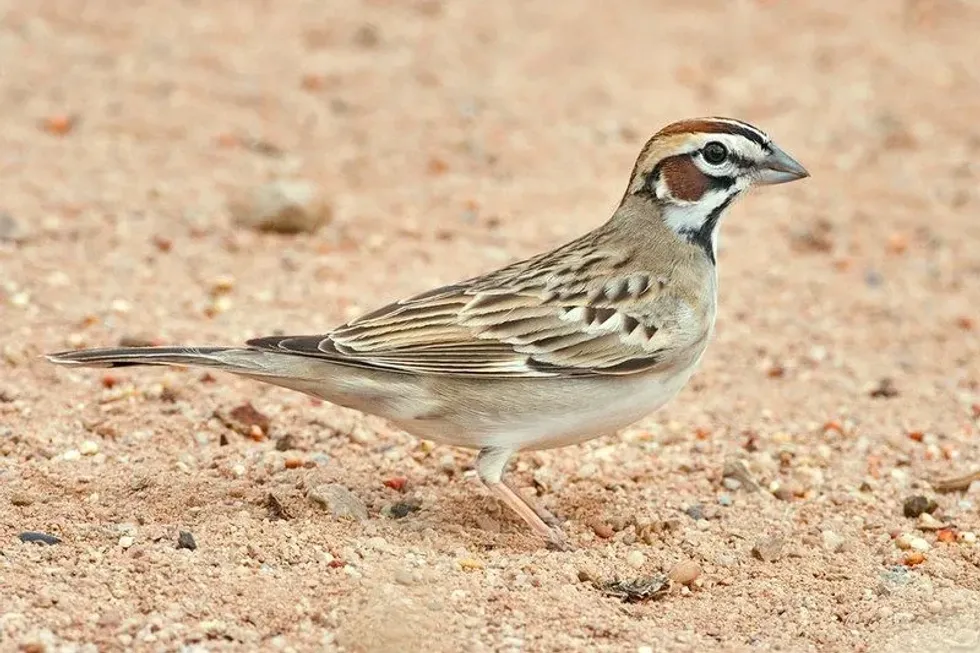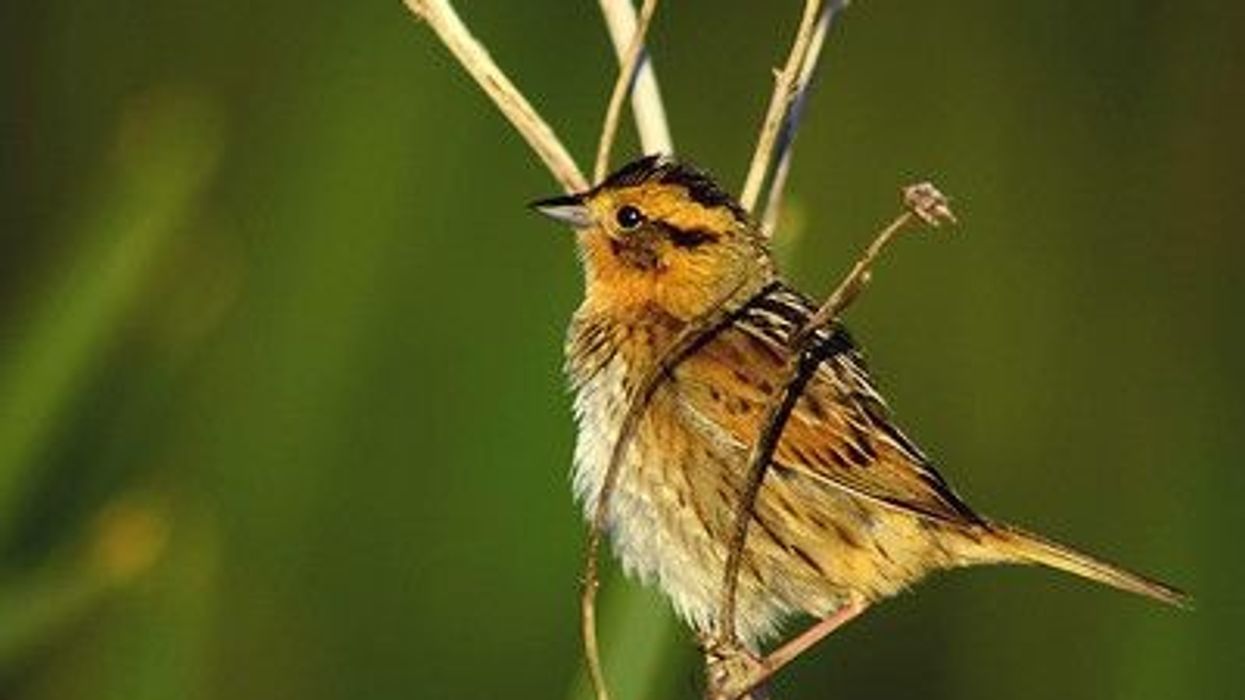Have you ever heard a melodious song of a bird giving joy and happiness, giving a feeling of a strong connection with nature? Then, it could most likely be a Lark sparrow singing. These birds from northern America are chirpy and sing beautifully. Read more about these interesting birds, their living habits, and more.
The word Lark means a small bird that makes a melodious sound. A unique feature is that they sing even when flying and not only when perched on trees. Lark sparrows mimic other birds too!
Another meaning of lark is a source of amusement. They bring cheerfulness and remind us to find joy in admiring nature. Many qualities of Lark sparrows make them a fascinating species of birds.
Are you interested to know more facts about these birds? Read ahead and also check out our articles on the bobwhite quail and chimney swift.
Lark Sparrow Interesting Facts
What type of animal is a lark sparrow?
The Lark sparrow (Chondestes grammacus) is a bird with distinct features, and it is the only member of the genus Chondestes. It is quite a large new world sparrow.
New world sparrows are a group of new world passerine birds forming the family of Passerelledae. They eat seeds, have conical bills, are brown or gray, and have distinct head patterns.
What class of animal does a lark sparrow belong to?
The Lark sparrow (Chondestes grammacus) belongs to the class Aves, order Passeriformes family. Another close cousin of this species is Fischer's Lark sparrow, a passerine bird in Alaudidae.
How many lark sparrows are there in the world?
The breeding population is expected to be almost 11 million. There has been a significant reduction in the Lark sparrow population since 1970.
Where does a lark sparrow live?
The habitat of this bird includes grasslands, scattered bushes, and open forests. It is found in central regions of North America, south Canada, and northern Mexico during the breeding season.
The Lark sparrow winter is spent in southern areas like South America, Mexico, and the south of Guatemala. In Texas, they are year-round residents. It is more found in the northern parts and much less common in the east.
What is a lark sparrow's habitat?
These are open-country birds that live on trees, bushes, pastures, farms, open woodland, grassland, savanna, and prairies. In winter and migration season, they can also live in semi-arid areas and bushy fields apart from the above areas.
Who do lark sparrows live with?
They forage in groups and fly long distances in large groups. During migration in winter, they form feeding flocks and mingle with other species of sparrows like white-crowned sparrows or vesper sparrows.
How long does a lark sparrow live?
The average life span of Lark sparrows is 94 months. Generally, sparrows can live up to 11 years, though many die in the first year of life itself.
How do they reproduce?
The breeding season starts in April and continues until July. Their breeding mechanism is unique.
A monogamous pair is formed by the male and female, for a single season. They have unusual courtship behavior. The male sparrow hops in a line and crouches down, lifting its tail feathers to show off the white color.
It struts with its wings on the ground, and when the female is receptive, it gives a small twig before copulation. The male does not tolerate another male sparrow in this area and lifts its head, indicating the same. Often it may lead to both males grappling in mid-air.
Other female intruders are generally received with courtship signals. Once the copulation is over, the males become more tolerant and forage together in groups.
The female selects the site in grassland and builds the nest on the ground or in trees. If built on trees, the nests are generally built about 7 ft higher than ground level. Nests are open cups of twigs, grass, animal hair, and bark.
The male may help bring the twigs, but the female does actual Lark sparrow nesting as a thick base. After mating, the Lark sparrow female lays three to six eggs in the nest. The female incubates it for 11 -12 days, after which they hatch.
These eggs are creamy to grayish-white in color with brown and black spots. The eggs hatch and nestlings arrive.
They stay in the nests for 9-10 days and then leave the nest. Both work together in feeding the young ones and protecting them until they fly. The young ones are mostly fed with insects only.
Lark sparrows also share parental responsibilities in creating the nest, protecting the eggs, and feeding the young ones until they fly. They are monogamous and form a pair for a breeding season.
What is their conservation status?
As per the IUCN, its status is of Least Concern. But the population of Lark sparrows is reducing significantly due to urbanization and the reduction of their natural habitats like grasslands.
Deforestation decreases the supply of food and shelter for the birds and results in habitat loss. Though this species is widespread, they are slowly becoming endangered due to human interference.
Lark Sparrow Fun Facts
What do lark sparrows look like?
A Lark sparrow is a bird with distinctive features. Its body is brown-gray with a white underside. It has a white and chestnut color head with a white eyebrow and dark brown crown stripes. The Lark sparrow tail is long with white triangles, visible when flying.
A black spot is conspicuously present on its white breast. This spot on its breast is a unique feature. A Lark sparrow juvenile has lighter shades of color. The Orange-breasted Lark sparrow is similar to a finch.
How cute are they?
The Lark sparrow bird is a super singer. It is undoubtedly a cute little bird with adorable features, chirping sounds, and unharmful nature.
How do they communicate?
Lark sparrows have a sharp tink in their chirp. When they flock together, these vocal signals are used to attract mates, deter enemies, and warn others in their group. In general, sparrows communicate by body postures and positions to communicate with other members of their species.
How big is a lark sparrow?
The Lark sparrow is about 7 in (17.8 cm) long with a wing length of about 11 in (27.9 cm). This could be twice as big as an American Goldfinch.
How fast can a lark sparrow fly?
Lark sparrows forage on the ground but fly swiftly when disturbed. In general, a sparrow can fly at a speed of 24 mph. This speed can go up to 31 mph (49.9 kph) when in danger, and they have to escape from their predators.
How much does a lark sparrow weigh?
These tiny birds can weigh up to 1.2 oz (34 g).
What are the male and female names of the species?
There isn't any specific name for male and female species. We can simply term a female as a female Lark sparrow and a male as a male Lark sparrow.
What would you call a baby lark sparrow?
Lark sparrow eggs, after hatching, are called nestlings. The young ones are referred to as chicks.
What do they eat?
They eat seeds, grains, insects, grasshoppers, beetles, and anthropods. The young ones are mainly fed by arthropods.
Are they aggressive?
Lark sparrows mostly flock in groups like other species of sparrows. They are very social but can be aggressive when they compete for a mate or to protect themselves. When nested in a single cage, sparrows can be so aggressive that one can be found dead as it competes for food.
Would they make a good pet?
Lark sparrows are not known as pets. In general, sparrows are social and need friends to be mentally healthy. So caging them can make them aggressive, and they can develop habits of hurting themselves or the owners if unhappy. Other birds like the canaries and finches make much better pets.
Did you know...
Lark sparrows have a positive economic impact by helping the farmers as they eat grasshoppers and are used for pest control to protect the farms from insects.
Now that you know about a Lark sparrow, you can put some seeds and water on the ledge of your balcony or in your yard to attract them.
What does a lark sparrow sound like?
The male Lark sparrow song is melodious. The jumble of clear notes and trills and interspaced with churrs, buzzes are heard frequently. It starts with a buzz followed by clear notes. Then, a few notes at a low pitch with a final clear trill. They even switch the notes in a different order.
What is a lark sparrow's courtship dance?
While breeding/courting, the male hops in a line and then crouches on the ground holding his tail up at an angle. He then spreads his tail feathers, showing off the white tips, and struts with his wings drooping nearly to the ground resembling a turkey. This act is a dance to attract the female Lark sparrow.
Here at Kidadl, we have carefully created many interesting family-friendly animal facts for everyone to discover! Learn more about some other birds including shrike or killdeer.
You can even occupy yourself at home by drawing one on our lark sparrow coloring pages.









